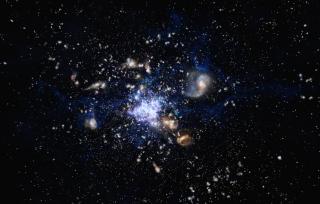Bibcode
Duivenvoorden, S.; Oliver, S.; Scudder, J. M.; Greenslade, J.; Riechers, D. A.; Wilkins, S. M.; Buat, V.; Chapman, S. C.; Clements, D. L.; Cooray, A.; Coppin, K. E. K.; Dannerbauer, H.; De Zotti, G.; Dunlop, J. S.; Eales, S. A.; Efstathiou, A.; Farrah, D.; Geach, J. E.; Holland, W. S.; Hurley, P. D.; Ivison, R. J.; Marchetti, L.; Petitpas, G.; Sargent, M. T.; Scott, D.; Symeonidis, M.; Vaccari, M.; Vieira, J. D.; Wang, L.; Wardlow, J.; Zemcov, M.
Referencia bibliográfica
Monthly Notices of the Royal Astronomical Society, Volume 477, Issue 1, p.1099-1119
Fecha de publicación:
6
2018
Número de citas
23
Número de citas referidas
21
Descripción
High-redshift, luminous, dusty star-forming galaxies (DSFGs) constrain
the extremity of galaxy formation theories. The most extreme are
discovered through follow-up on candidates in large area surveys. Here,
we present extensive 850 μm SCUBA-2 follow-up observations of 188 red
DSFG candidates from the Herschel Multitiered Extragalactic Survey
(HerMES) Large Mode Survey, covering 274 deg2. We detected 87
per cent with a signal-to-noise ratio >3 at 850 μm. We introduce a
new method for incorporating the confusion noise in our spectral energy
distribution fitting by sampling correlated flux density fluctuations
from a confusion limited map. The new 850 μm data provide a better
constraint on the photometric redshifts of the candidates, with
photometric redshift errors decreasing from σz/(1 + z)
≈ 0.21 to 0.15. Comparison spectroscopic redshifts also found little
bias (<(z - zspec)/(1 + zspec)> =
0.08). The mean photometric redshift is found to be 3.6 with a
dispersion of 0.4 and we identify 21 DSFGs with a high probability of
lying at z > 4. After simulating our selection effects we find number
counts are consistent with phenomenological galaxy evolution models.
There is a statistically significant excess of WISE-1 and SDSS sources
near our red galaxies, giving a strong indication that lensing may
explain some of the apparently extreme objects. Nevertheless, our sample
includes examples of galaxies with the highest star formation rates in
the Universe (≫103 M⊙ yr-1).
Proyectos relacionados

Gas Molecular y Polvo en Galacias através del Tiempo Cósmico
Dos cuestiones fundamentales en la Astrofísica son la conversión de gas molecuar en estrellas y cómo este proceso físico depende del entorno en todas las escalas, desde sistemas planetarios, cúmulos estelares, galaxias hasta cúmulos de galaxias. El objectivo principal de este proyecto es el de estudiar la formación y evolución de galaxias a partir
Helmut
Dannerbauer